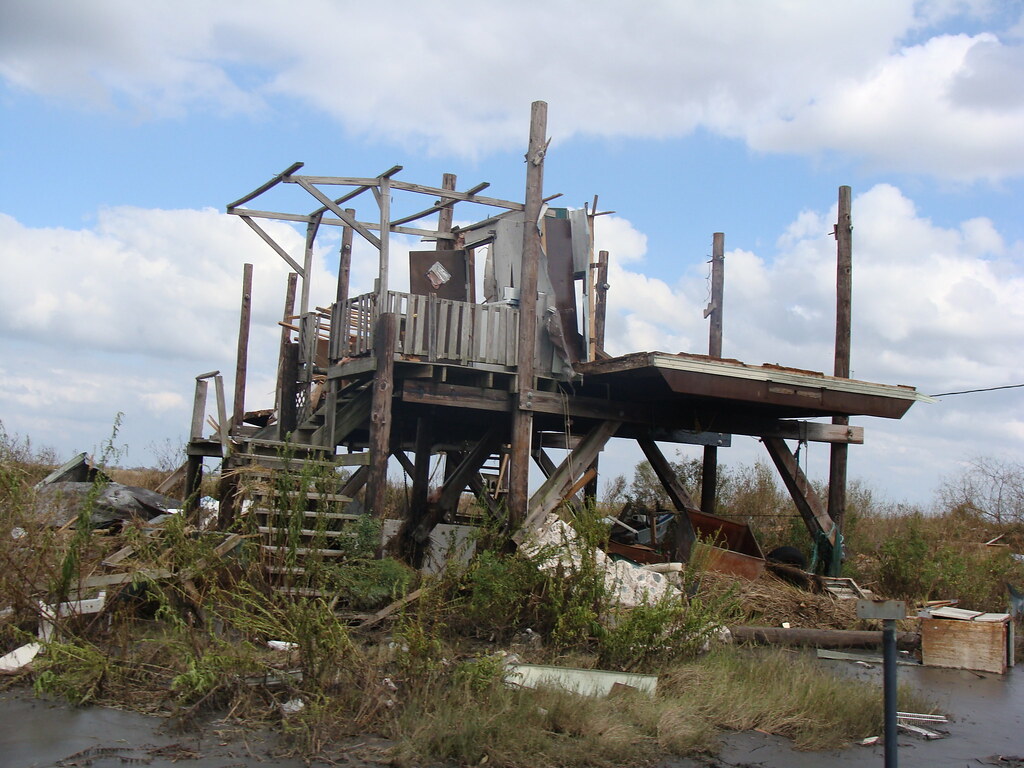Climate Change and a Vanishing Island
Posted by Patricia Devine on August 11th, 2016
Posted in: News From NNLM PNR
This article about the effects of climate change on the people who live on a small island in the bayous of Louisiana is from the NN/LM South Central Region’s blog, Blogadillo.
SCR Regional Highlight: America’s First “Climate Refugees”
“Isle De Jean Charles” by Karen Apricot
is licensed under CC BY 2.0
 Isle de Jean Charles is a tiny, narrow island deep in the bayous of Louisiana. The single-lane “Island Road” is the only land method of transportation to and from the island but is often impassible during times of high water. It has been the home to the Isle de Jean Charles Band of Biloxi-Chitimacha-Choctaw Indians for more than 170 years—but not for much longer.
Isle de Jean Charles is a tiny, narrow island deep in the bayous of Louisiana. The single-lane “Island Road” is the only land method of transportation to and from the island but is often impassible during times of high water. It has been the home to the Isle de Jean Charles Band of Biloxi-Chitimacha-Choctaw Indians for more than 170 years—but not for much longer.
Coastal erosion, severe storms, rising sea levels, and poor oil extraction practices have caused the island to literally sink into the Gulf of Mexico. Current island residents remember when Isle de Jean Charles was 5 miles wide. But with 98 percent of it lost since 1955, the island is now only a mere 1/4 mile in width. Southern Louisiana as a whole, actually, is the fastest disappearing landmass on earth.
Edison Dardar, one of the current residents, explains in The New York Times’ mini-documentary “Vanishing Island” that he remembers when there were 250, maybe even 300 homes, on the island years ago. Since the hurricanes have scared most families off, there are now maybe 20 left. Hurricanes Katrina, Rita, Gustav and Ike severely damaged the infrastructure of the island causing many families to flee.
Since 2010, Chief Albert Naquin and tribal leaders, realizing the island they and their ancestors have called home for almost two centuries won’t be around for much longer, have been trying to create a solution by finding a way to relocate the remaining 77 residents. After working with the Lowlander Center for more than five years, they finally received some good news.
In January, the U.S. Department of Housing and Urban Development announced it would grant more than $1 billion in total to 13 communities who have been impacted by major disasters between 2011 and 2013 through the Housing and Urban Development’s National Disaster Resilience Competition Grant. The grant to assist the community of the Isle de Jean Charles is something new, however. Never before have federal tax dollars been used to relocate an entire community struggling with the effects of climate change. This is a big step for Naquin and island residents — the grant allocates more than $92 million to the state of Louisiana to be split between one other project, the Louisiana Strategic Adaptations for Future Environments Program.
“Isle De Jean Charles” by Karen Apricot
is licensed under CC BY 2.0
 Now Naquin and tribal leaders face a new challenge, relocating those residents who still want to stay. Isle de Jean Charles residents have varying views when it comes to resettlement. Some are excited to leave the disappearing island behind; others are afraid they will lose their culture if they move away. While the exact path of resettlement for Isle de Jean Charles is still uncertain, the tribe could relocate as early as 2019.
Now Naquin and tribal leaders face a new challenge, relocating those residents who still want to stay. Isle de Jean Charles residents have varying views when it comes to resettlement. Some are excited to leave the disappearing island behind; others are afraid they will lose their culture if they move away. While the exact path of resettlement for Isle de Jean Charles is still uncertain, the tribe could relocate as early as 2019.
It’s also important to note that Isle de Jean Charles is not the only community dealing with the consequences of climate change; The New York Times reported that 50 million to 200 million people could be displaced because of climate change by 2050. While Isle de Jean Charles residents may be the first climate refugees, they certainly will not be the last.
To learn more about the Island’s history, visit isledejeancharles.com.
Watch the mini-documentary “Vanishing Island” produced by The New York Times.
To learn more about the Housing and Urban Development’s National Disaster Resilience Competition Grant, please visit hud.gov.
Follow NN/LM SCR on Twitter and like us on Facebook.
–Written by Sara Goodwin, NN/LM SCR
 ABOUT Patricia Devine
ABOUT Patricia Devine
Medical Librarian, Network Outreach Coordinator, NN/LM, PNR. I work for a network of libraries and organizations with an interest in health information.
Email author
Visit author's website
View all posts by Patricia Devine
 Isle de Jean Charles is a tiny, narrow island deep in the bayous of Louisiana. The single-lane “Island Road” is the only land method of transportation to and from the island but is often impassible during times of high water. It has been the home to the Isle de Jean Charles Band of Biloxi-Chitimacha-Choctaw Indians for more than 170 years—but not for much longer.
Isle de Jean Charles is a tiny, narrow island deep in the bayous of Louisiana. The single-lane “Island Road” is the only land method of transportation to and from the island but is often impassible during times of high water. It has been the home to the Isle de Jean Charles Band of Biloxi-Chitimacha-Choctaw Indians for more than 170 years—but not for much longer.


 ABOUT Patricia Devine
ABOUT Patricia Devine